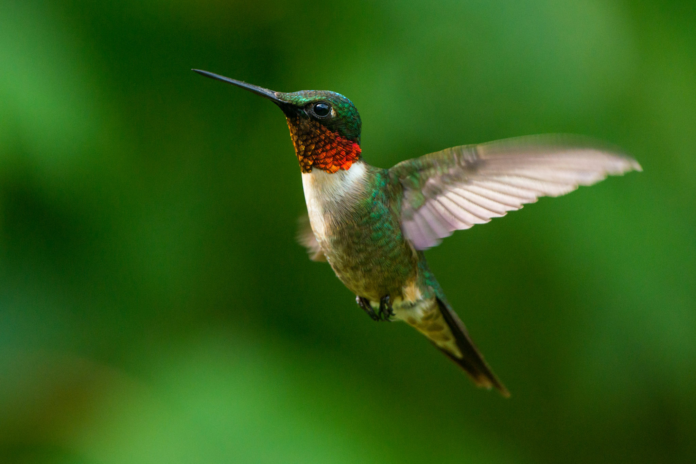Northern Illinois, with its diverse landscapes and changing seasons, is a region blessed with the magical presence of hummingbirds. These tiny, iridescent creatures bring joy and wonder to backyard enthusiasts and nature lovers alike. In this article, we’ll explore the enchanting world of hummingbirds in Northern Illinois, learning about their species, migration patterns, and how to create an inviting haven for these delightful birds right in your own backyard.

Hummingbird Species in Northern Illinois:
1. Ruby-Throated Hummingbird (Archilochus colubris):
- The most common hummingbird species in Northern Illinois is the Ruby-Throated Hummingbird. Recognized by the vibrant red patch on the throat of males, these small wonders are a sight to behold as they zip through gardens and wooded areas.

2. Rufous Hummingbird (Selasphorus rufus):
- While less common, the Rufous Hummingbird is occasionally spotted in Northern Illinois during migration. Identified by their orange-brown coloring and territorial nature, spotting a Rufous Hummingbird is a treat for birdwatchers.
3. Other Possible Visitors:
- Northern Illinois serves as a migratory pathway, potentially attracting other hummingbird species during their journeys. While less frequent, species like the Black-Chinned Hummingbird or the Broad-Tailed Hummingbird may make appearances.
Hummingbird Migration in Northern Illinois:
1. Spring Arrival:
- Ruby-Throated Hummingbirds typically arrive in Northern Illinois in late April to early May. As the weather warms, they make their way north from their wintering grounds in Central America.
2. Fall Departure:
- The hummingbirds begin their southern migration in late summer, with peak migration occurring in September. To prepare for their journey, they fuel up on nectar and insects, doubling their body weight for the long flight ahead.
3. Creating a Migration-Friendly Habitat:
- To attract and support hummingbirds during migration, plant a variety of nectar-rich flowers and flowering shrubs in your garden. Native plants like bee balm, trumpet vine, and columbine are excellent choices.
Creating a Hummingbird-Friendly Garden:
1. Choose Brightly Colored Flowers:
- Hummingbirds are attracted to brightly colored flowers, especially those in shades of red, orange, and pink. Include flowers like salvia, fuchsia, and zinnias in your garden to capture their attention.
2. Provide a Range of Blooming Plants:
- Ensure a continuous supply of nectar by planting a variety of flowers that bloom at different times throughout the spring and summer. This ensures a consistent food source for visiting hummingbirds.
3. Hang Hummingbird Feeders:
- Supplement natural nectar sources by hanging hummingbird feeders in your garden. Opt for feeders with vibrant colors to attract their attention. Prepare a simple nectar solution using four parts water to one part white granulated sugar.
4. Offer Perches and Shelter:
- Hummingbirds appreciate perches to rest between feeding flights. Place small branches or thin rods near feeders. Additionally, provide trees or shrubs for shelter, allowing them to rest and feel secure in your garden.
Interesting Hummingbird Behaviors:
1. Territorial Displays:
- Male hummingbirds are known for their territorial nature. They perform elaborate aerial displays, diving and swooping to assert dominance over a feeding area.
2. High Metabolism and Feeding Frequency:
- Hummingbirds have incredibly high metabolisms and must feed frequently. They consume half their body weight in nectar daily, visiting hundreds of flowers and feeders.
3. Unique Feeding Technique:
- The hummingbird’s feeding technique is fascinating. Their long bills and extendable, tube-like tongues allow them to extract nectar from deep within flowers. They are also adept at catching insects in mid-air for protein.
Conservation and Preservation Efforts:
1. Reduce Pesticide Use:
- Minimize pesticide use in your garden, as hummingbirds can be negatively affected by these chemicals. Opt for natural pest control methods to protect both your garden and these delicate visitors.
2. Support Native Plant Species:
- Planting native flowers and shrubs provides a sustainable and natural habitat for hummingbirds. Native plants are adapted to the local environment, offering the right balance of nectar and insects.
3. Participate in Citizen Science:
- Contribute to hummingbird research by participating in citizen science projects. Organizations like eBird and Journey North collect valuable data on hummingbird sightings and migration patterns.
Conclusion: Enchanting Hummingbirds in Northern Illinois
In conclusion, Northern Illinois becomes a canvas of enchantment when hummingbirds grace the region with their presence. By understanding their migration patterns, creating a hummingbird-friendly garden, and supporting conservation efforts, you can play a role in preserving the magic of these extraordinary birds.
Invite these tiny jewels into your backyard, and witness the joy they bring as they flit and hover, adding a touch of wonder to the natural tapestry of Northern Illinois. Embrace the hummingbird magic, and let your garden become a haven for these delightful creatures.


